Christianity Introduced in Viken—Erling Skialgson of Sole—Great Opposition to Christianity—Founding of the Town of Nidaros—Olaf woos Queen Sigrid the Haughty—He marries Thyra from Denmark—Building of the “Long Serpent”—Einar Thambaskelfer—Expedition to Vendland—Battle of Svolder—Death of Olaf Trygvason
OLAF TRYGVASON was twenty-seven years old when he came to Norway. At a general Thing at Throndhjem the people elected him king of all Norway, as Harald the Fairhaired had been, and in return he promised to enforce law and justice. The following spring and summer Olaf travelled through the whole country, to the southernmost part of Viken, and everywhere he was hailed as king, even by the chiefs in the Uplands and in Viken, who, during the reign of Earl Haakon, had at least nominally acknowledged the suzerainty of the Danish king. In the Uplands the petty kings, who were descendants of Harald the Fairhaired, were allowed to retain their possessions on the old conditions.
Olaf had decided, before he left England, to introduce Christianity in Norway, and he found it advisable to commence this work in Viken, where he had many of his relatives and warmest friends. Here was the rich and influential Lodin, who, some time before, had married Olaf’s mother Astrid. His mother’s brothers and two brothers-in-law of Olaf were also mighty people in that part of the country. Another reason for starting the work here was that a good many had already adopted the Christian faith under the influence of missionaries from Germany and Denmark. During his stay in Viken, Olaf called his relatives together and informed them of his intention to convert the whole of Norway to the Christian faith. He would accomplish that, he said, or die in the attempt. But he promised to make his relatives great and mighty men if they would support him with all their power. This they agreed to do, and as the most powerful men among the people had now acceded to King Olaf’s request, the others followed their example, and all the inhabitants of the east part of Viken allowed themselves to be baptized. Greater opposition was met in the north part of Viken (around “Folden”), where Christianity had not had so many former adherents. But Olaf would tolerate no opposition; those who opposed him he punished severely, killing some, mutilating others, and driving some into banishment. During that summer (996) and the following winter all Viken was made Christian.
The next spring King Olaf christianized Agder. He met no opposition until he came to Hordaland, where there were many mighty men. They met him fully armed at a public assembly, ready to resist; but after he had made his speech entreating them to accept Christianity, but adding that those who would not submit must expect punishment, their courage failed them, and all the people present were baptized before the assembly was dissolved. King Olaf then went with his men to the Gula-Thing, where one of the chieftains asked of the king, as a sign of goodwill, that he give his sister Astrid in marriage to their relation, Erling Skialgson of Sole, whom they looked upon as one of the most hopeful men in the country. This the king readily acceded to, since Erling was a man of good birth and fine appearance. Erling Skialgson and Astrid were married in the summer, and the king, who was present at the wedding, at his departure invested Erling with all the land north of the Sogne Fjord and east to the Lidandisnes, on the same terms as Harald the Fairhaired had given land to his sons.
After having christianized the people of Sogn, South More, Raumsdal and North More, King Olaf, after a year’s absence, returned to Throndhjem. At Lade he had the great heathen temple razed to the ground, took all the ornaments, and burned the temple with all the images. When the people heard of this they sent out war-tokens and collected a great force, with which they intended to attack the king. In the meantime Olaf sailed with his men out of the fjord along the coast northward, intending to proceed to Halogaland and baptize there. But when he came out to Bjarnaurar (Björnör), he heard from Halogaland that a force was assembled there to defend the country against the king. The chiefs of this force were Harek of Thiotta, Thorer Hiort from Vagar, and Eyvind Kinrifa. At the same time he learned that the peasants in Throndhjem had now dispersed. He therefore turned about and sailed in through the Throndhjem Fjord again.
In the fall King Olaf laid the foundation of the future city of Nidaros at the mouth of the river Nid. He built his royal residence at Skipakrok (the ships’ creek), built a church further up, and laid out building lots for the people. The work was pushed forward with energy, so that Olaf could take up his residence there in the winter, and by Christmas the church was also ready.
At the beginning of the winter Olaf summoned the peasants to a Thing at Frosta, and they came in great numbers, but also well armed. When the Thing was called to order, the king began in a mild manner to preach Christianity; but the peasants soon objected, and the mighty Jernskegge (Ironbeard), who was their spokesman, said that the will of the people was now, as formerly, that the king should not break the laws. They wanted the king to offer sacrifice, as other kings before him had done. If he did not do as they wanted, they would kill him or banish him from the country. Seeing that the people were in earnest, and had a superior force present, King Olaf talked to them in a more conciliatory manner, promised to be present at their midwinter sacrifices, and said that they could then further discuss the proposed change of faith. This speech was well received, and the assembly dispersed.
When Yuletide came, Olaf invited all the mighty peasants from Strinden, Gaulardal, and Orkadal to a feast at Lade. They came, were entertained in the best possible manner the first evening, and toward morning became quite drunk. The next day he called a House-Thing, where his men were present in much greater number than the peasants. He made a speech, in which he said that at Frosta he had offered them Christianity, but instead of accepting it they had demanded that he should offer sacrifice to their gods, as other kings had done. “Now,” he continued, “if I shall turn again to making sacrifice, then will I make the greatest of sacrifices that are in use, and I will sacrifice men. But I will not select slaves or malefactors for this, but will take the greatest men only to be offered to the gods.” Thereupon he selected eleven of the principal men, and all these, he said, he would offer in sacrifice to the gods for peace and a fruitful season, and ordered them to be laid hold of immediately. As the peasants saw that resistance was useless, they all submitted to the king’s demands. He spared their lives on the condition that they should be baptized, take an oath to support the true faith, and renounce all sacrifices to the heathen gods. They were then baptized, and had to send their sons, brothers or other near relations as hostages. Later on, King Olaf came with his men to Mærin, where the people were assembled. He promised to go into their temple to look at their ceremonies; but while there, he and his men knocked down and demolished the images of the gods, while the chief of the peasants, Jernskegge, was killed outside of the temple by one of the king’s men. When the king came outside, he demanded that the peasants be baptized, or fight with him on the spot, and as their chief was dead, and there was a superior force against them, they yielded, were baptized, and gave hostages for their perseverance in the faith.
In this and similar ways King Olaf succeeded in christianizing, in name at least, practically the whole of Norway. Christianity was also introduced in Iceland, the Faroe Islands, and the Orkneys.
Queen Sigrid the Haughty (Storraade), widow of King Erik of Sweden, resided on her large estates in Gautland and wielded a great influence. Her son, Olaf the Swede, besides being king of Sweden, also ruled over Denmark, whence Svein Tjuguskeg had been expelled. Many were her wooers, but she had so far rejected all, and she even caused two of them, her foster-brother Harald Grenske and the Russian king Vsevolod, to be killed, by being burned in their lodgings, in order, as she said, to make petty kings quit courting her. Olaf Trygvason evidently thought that it would strengthen him if he could marry Sigrid, and sent messengers to her with a request for her hand. They were well received, and it was agreed that Olaf and Sigrid should meet at Konungahella, at the boundary line between Norway and Sweden, early in the spring. King Olaf sent Queen Sigrid as a gift the great gold ring he had taken from the heathen temple at Lade. She was greatly pleased with this ring, and had it passed around in her hall to be admired. When it came to her two goldsmiths they shook their heads, and upon being pressed, pronounced the ring false. The queen ordered the ring to be broken into pieces, and it was found to be copper inside. Sigrid became very angry, and said that Olaf would probably deceive her in more ways than this one.
Early in the spring Olaf met Queen Sigrid at the appointed place, and it seemed that they were coming to an agreement. But when Olaf insisted that Sigrid should become a Christian and be baptized, she answered: “I must not part from the faith which I have held, and my forefathers before me; but, on the other hand, I shall make no objection to your believing in the god that pleases you best.” Then King Olaf became angry and struck her in the face with his glove, saying: “Why should I care to have thee, an old faded woman, and a heathen jade?” Greatly enraged Sigrid cried: “This may some day be thy death.” Thus they parted. The king set off to Viken, and the queen returned to Gautland.
King Olaf unexpectedly met a new bride. The Danish king, Svein Tjuguskeg, had compelled his sister Thyra to marry King Burisleif of Vendland;1 but Thyra had been with this heathen and dissolute husband only a week when she fled back to Denmark, and afterward, in order to avoid her brother, went to Norway, where she met King Olaf. “Thyra was a well-spoken woman,” says the saga, “and the king had pleasure in her conversation.” He also saw that she was a handsome woman, although she can not have been very young at that time, and the result was that they were married, much against the wish of Svein Tjuguskeg.
Shortly after this Sigrid the Haughty married Svein Tjuguskeg, who, by this relationship with King Olaf the Swede, recovered back his kingdom, Denmark. Their family connections also included the two sons of the late Earl Haakon, Erik, who married Svein Tjuguskeg’s daughter Gyda, and Svein, who married Holmfrid, a sister of Olaf the Swede. Thus the chain was formed, which for a long time was to have influence on the destiny of Norway.
Olaf Trygvason and his wife, Thyra, spent the winter after their marriage at Nidaros (Throndhjem). Queen Thyra often complained, and wept bitterly over it, that she, who had great possessions in Vendland, had no property here suitable for a queen, and she entreated the king to go to Vendland and have her property there restored to her. But all King Olaf’s friends advised him not to undertake such an expedition. It is told that on Palm Sunday the king was walking in the street, and met a man with a number of fine angelica roots, remarkably large for that early season. The king bought one, and brought it home to Queen Thyra, whom he found crying. He said to her: “See here, queen, is a great angelica stalk, which I give thee.” But she threw it away and said: “A greater present my father, Harald Gormson, gave to my mother; and he was not afraid to go out of the country and take what was his; but thou darest not go across the Danish dominions for that brother of mine, King Svein.” Then King Olaf sprang up, and answered with a loud oath: “Never did I fear thy brother, King Svein; and if we meet he shall give way before me!”
Shortly after Easter the king convoked a Thing in the town, and proclaimed to the people that in the summer he would go upon an expedition abroad, and announced how many ships and men he wanted from each district. The king had then just finished a ship which was larger and more magnificent than any other ship in the country. This ship was called the “Long Serpent” (Ormen lange). The crew was made up of picked men of great strength and courage, none of them more than sixty or less than twenty years of age. The only exception was Einar Thambaskelfer, who was only eighteen years old. Einar was unusually strong, and was considered the most skilful archer. He had a bow called Thamb, which he was wont to make quake; hence his name (Thambaskelfer, i.e., Thamb-quaker). The king himself commanded the “Long Serpent.” His half-brother, Thorkel Nefia, commanded the “Short Serpent,” and his mother’s brothers, Thorkel Dydril and Jostein, had the “Crane” (Tranen), and both these ships were well manned. King Olaf had sixty ships when he left Norway, and sailed southward through the Sound to Vendland. With him, on board the “Long Serpent,” were Queen Thyra, his sister Ingibjorg, bishop Sigurd, and several priests. Many of his friends had joined him on the journey south along the Norwegian coast, among them his brother-in-law, Erling Skialgson of Sole, who had a large and well-equipped ship. When King Olaf arrived in Vendland, he was well received by King Burisleif, his claims to Queen Thyra’s estates were peaceably settled, and he remained there a portion of the summer.
Sigrid the Haughty was Olaf Trygvason’s bitterest enemy after their meeting at Konungahella, when he struck her in the face with his glove. She urged King Svein much to fight King Olaf, saying that he had the more reason to do so, as Olaf had married his sister Thyra without his leave. King Svein finally resolved to attack King Olaf. He sent messengers to his brother-in-law, King Olaf the Swede, and to Earl Erik, inviting them to join him with an army, so that they all together might attack King Olaf Trygvason. He also sent Earl Sigvald to Vendland to spy out Olaf Trygvason’s movements, and by pretending friendship gain his confidence and lead him into a trap.
Between the island of Rügen and the mainland of the present Prussian province of Pomerania lies a little island called Greifswalder Oie, or Svolder, as it was called at that time. Here lay on the 9th of September, in the year 1000, a fleet of eighty ships. Sixty of them belonged to the Danish king Svein Tjuguskeg, fifteen to the Swedish king Olaf, and five to Earl Erik. They lay there waiting for King Olaf to pass by on his return home from Vendland.
With a light but favorable breeze the Norwegian fleet sailed out of the harbor, where it had been lying during the stay in Vendland. All the small vessels, which sailed faster, got out to sea before the others. Earl Sigvald with his ships remained near the king for a while, and then sailed ahead telling the king to sail in his keel-tracks, as he knew best where the water was deepest. The earl, who was informed of the presence of the Danish fleet, sailed close under the island of Svolder, and Olaf Trygvason with his remaining eleven large ships followed. Meanwhile the Danish king Svein, the Swedish king Olaf, and Earl Erik, gathered their forces and made ready for battle.
When Olaf Trygvason sailed in toward the island, the whole fleet of the enemy came out against him. When his chieftains saw this superior force they begged the king to proceed on his way, and not risk a battle against such odds. But the king, standing high on the quarter-deck of the “Long Serpent,” replied: “Strike the sails; never shall men of mine think of flight. I never fled from battle. Let God dispose of my life, but flight I shall never take.”
King Olaf ordered the ships to close up to each other. The “Long Serpent” lay in the middle of the line; on one side lay the “Little Serpent,” and on the other the “Crane.” King Olaf stood on the quarter-deck of the “Serpent,” high over the others. He had a gilt shield, and a golden helmet, and over his armor he had a short red jacket, so that he was easily distinguished from the others. When he saw the enemy’s ships drawing up for battle, he asked: “Who is the chief of the force right ahead of us?” The answer came that it was King Svein with the Danish army. The king said; “We are not afraid of these soft Danes, for there is no courage in them. But who are those on the right?” He was answered, that it was King Olaf with the Swedish forces. “Better it were,” said King Olaf, “for these Swedes to stay at home licking their sacrificial vessels,2 than to come under our weapons. But who owns the large ships on the other side of the Danes?” “That is Earl Erik, the son of Haakon,” said his men. Then the king said: “He, methinks, has good reason for meeting us; and from these men we may expect the sharpest conflict, for they are Northmen like ourselves.”
The battle commenced and became very severe, and many people were slain. King Svein made a violent attack on the “Long Serpent,” but was soon compelled to retreat. Then Olaf the Swede came up with his fifteen ships, but he fared no better, and the king himself had a narrow escape from death. When Earl Erik came up with his ships the fight became most severe, and a great number of people fell. The men from the smaller ships soon began to seek refuge on board the “Long Serpent,” and at last all King Olaf Trygvason’s ships were cleared of men except the “Long Serpent.” Then Earl Erik brought his ship up to the side of the “Serpent,” and the fight went on with battle-axe and sword.
Einar Thambaskelfer stood at the mast of the “Serpent” and sent deadly arrows from his bow. He sent an arrow at Earl Erik, which hit the tiller-end just above the earl’s head so hard that it entered the wood up to the arrow-shaft. The earl had hardly time to ask whose shot it was, when another arrow flew between his arm and his side, and clear through a board behind him. Again Einar drew his bow, when it was hit by an arrow from the enemy and broke in two. “What was it that broke with such a noise?” cried King Olaf. “Norway, king, from thy hands,” answered Einar. “Not so,” said the king, “take my bow and shoot,” and the king threw his own bow to Einar. Einar took the bow, and drew it over the head of the arrow. “Too weak, too weak,” said he, “is the bow of the king,” and, throwing it aside, he took sword and shield, and fought desperately.
Finally, after a terrible combat, the earl’s men boarded the “Serpent,” and the few men who were left were killed or leaped overboard. King Olaf held his shield over his head when he threw himself in the water, and was drowned. Among the last men to leave the ship were Einar Thambaskelfer, who was captured in the water, and Thorkel Nefia, who swam ashore.
King Olaf Trygvason was thirty-six years old when he fell at Svolder. His widow, Queen Thyra, died shortly afterward from grief.
Read next: Leif Erikson – The Discoverer of America
Author: Sigvart Sörensen


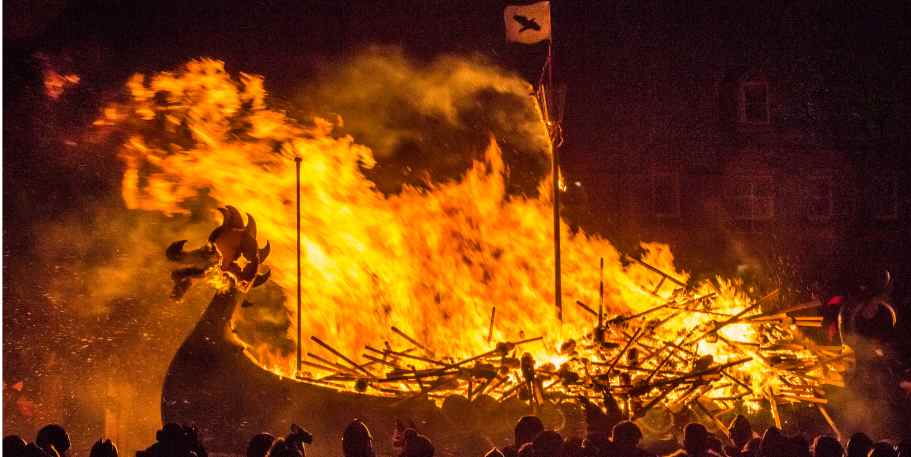

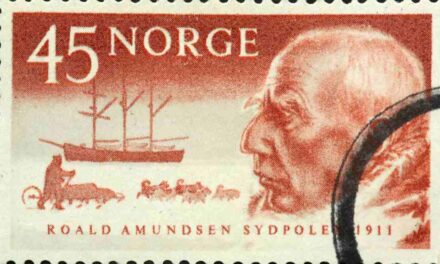


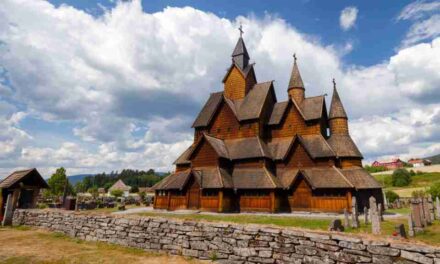




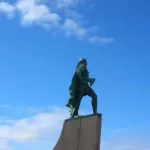
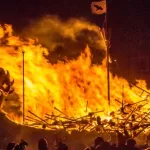

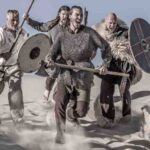
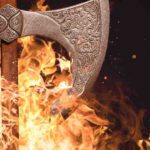
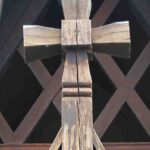
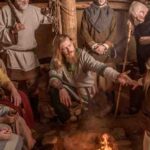
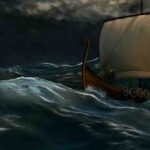
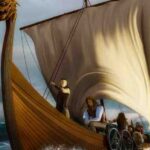
Trackbacks/Pingbacks